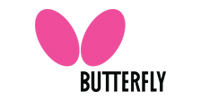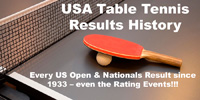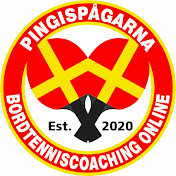Tip of the Week
In case some of you missed it, here is the link to yesterday's Tip of the Week: Where to Serve Short?
ITTF Coaching Course
What an incredible week! I returned late Saturday night from six days at the ITTF Level 2 Coaching Course taught by Richard McAfee at the Lily Yip Table Tennis Center in Dunellen, New Jersey, Mon-Sat. It's part of the ITTF's Coaching Development Program. I took the Level 1 Course two years ago in Colorado Springs, as well as a Course Conductor Course which qualified me to teach that course. (I've taught one so far.) Richard had been trained by ITTF to teach the Level 2 Course.
A big thanks goes to Richard McAfee, the course conductor, who (even as I write this) is teaching another course in Austin, Texas; to Lily Yip and Barry Dattel, our hosts at the Lily Yip TTC (where they even cooked us free lunches each day, often spaghetti or Chinese food); to Adam Hugh for letting us stay in his attic; and to the ITTF for creating the program.
I drove up to the course with fellow Maryland coach Jeff Smart (a past USATT Coaching Chair from long ago), who had received his Level 1 certification from the class I taught two years ago. I hate long distance driving, so I agreed to use my car if he'd do the driving. To save money, he and I spent the week in Adam Hugh's attic! (It was roomy and quite comfortable, and even had a bathroom.) At night we had many philosophical discussions on politics, religion, table tennis, and ice cream. We often agreed on the last two items.
Each day included two three-hour sessions plus lots and lots of homework and study. I brought a book to read in my free time, not realizing there wasn't going to be much free time. (Well, perhaps that's because of my somewhat obsessive outlook on studying.) About 1/3 of the time was spent in classroom on theory, the rest at the tables where Richard demonstrated the techniques, both from the book and from his own experience. Much of the table time was spent with the participants giving assigned lectures on various techniques.
Participants in the course were Sydney Christophe, Barry Dattel, Nelson Gore, Larry Hodges, Jeff Smart, Simplice Sourou, Mieczyslaw "Matt" Suchy, Doon Wong, Lily Yip, and Roger Yuen. It was quite a varied group.
Here's a rough day-by-day rundown.
DAY ONE: Coaches Presentation; Level 2 Presentation; General Principles of Sports Education; Basic Principles of Contact - "Peeling and Gumming" (grazing the ball and sinking it into the sponge) and "Carry, Dropshot, and Smashing" contacts (contact without adding speed or spin; contact where you remove speed and spin; contact where you add speed or spin); and Basic Principles of Spin. (What we call sidespin and corkscrewspin they call lateral and deviated spin.) I was also assigned to lecture on the ideas that "Winning isn't everything, it's the only thing" and "Sport is not war." I gave examples where these were true or false. Winning isn't everything or we'd all use poor sportsmanship to win (as some do). I argued that when we play sports, we think of ourselves as warriors, so sport can be thought of as war with rules - except war does have rules (no chemical weapons, for example), so they are more alike than we think. Main difference is few die in table tennis! I also gave a ten-minute training session on sidespin blocks.
DAY TWO: A Complete Technique (balanced game, speed, consistency, variation, adaptability); Observation; Techniques for Scoring the Point (power, speed, consistency, variation, placement); Movement; Proprioceptivity (knowing where your body is); and Free (strong leg) and Standing Leg (weak leg); and Producing Good Players. I was assigned to give a lecture on "What is Performance?", which covered Physical, Technical, and Psychological. I also ran a ten-minute session on the double-bounce push receive, where you push a serve back so that, given the chance, it would bounce twice on the opponent's side of the table, with the second bounce very near the end-line.
DAY THREE: Energy Pathways (Alactic Anaerobic, Lactic Anaerobic, and Aerobic, plus VO2Max, Maximum Aerobic Speed, Maximum Aerobic Power, and ways to improve Aerobic and Anaerobic fitness); Footwork; Serves. I was assigned to lecture on "Postural Adjustments for Covering the Middle," which I demonstrated for both forehand and backhand, as well as covering some of the historical development of these techniques. I also ran a ten-minute session on fast, deep serves.
DAY FOUR: Theory of Psychology and the Brain (such as, what does each hemisphere of the brain control and brain mechanics); Serve; Receive; Topspin (looping); Defense. I also ran a ten-minute session on backhand chopping.
DAY FIVE: More on Psychology; Blocking; Smashing; Multiball; Different Contacts. I also helped several coaches with their multiball skills. I also explained one of my favorite multiball slogans: Feed Fast, Feet Fast! I also ran a ten-minute session on smashing loops. (During this lecture I was "attacked" by the robot vacuum cleaner that roved the training center much of the time. Okay, it bumped into me as I lectured. I have to get one of those for MDTTC!)
DAY SIX: This was Testing Day. We started with a one-hour review session. Then we got to the testing. Many of us had spent much of our nights studying for this. There were two parts to the test. For the first part (worth 10 points) we were asked five different questions, and graded on how we answered them. I was asked questions on the Anaerobic Threshold (when the body begins to build up lactic acid in the muscles); on the left side of the brain (which controls emotion, speech, judgment, values, logic, and reason, as well as the right side of the body. Or was it the right brain I was asked about? Now I'm not sure, but that controls artistic, imagination, automatic body functions, proprioception, processes images and sound, and controls the left side); improving stability (wider stance, bend knees); Ways to Score the Point (power, speed, consistency, variation, placement); and one other that I can't remember offhand. I think it was Secondary Needs (achievement, recognition, and respect).
For the second part (also worth 10 points) we were each assigned a topic to run a ten-minute training session for four other coaches. I was assigned "Topspin to Topspin" (i.e. counterlooping). The four coaches in my group were Jeff Smart, Matt Suchy, Simplice Sourou, and Lily Yip (playing shakehand inverted instead of her usual pips-out penhold). It went pretty well. After a brief lecture and demo (with 2500+ Matt), I had them first do straight counterlooping, forehand to forehand, Jeff with Matt, Simplice with Lily. Then I had them do a version of multiball I like, where one player with a box of balls serves backspin, the other player pushes it back, the server loops, and the other player counterloops. The server doesn't play out the point; as soon as he loops against backspin he grabs another ball and repeats. It's a great way to learn to counterloop against a ball looped against backspin, which has a different trajectory than one looped against block or topspin. Lily (in her shakehand mode) tended to let her wrist fall back, and also tended to lean to the ball instead of step to it; Jeff tended to use too much upper body instead of more lower body; Simplice needed to pull more with his left side (he's a righty); Matt had pretty much perfect European bent-arm looping technique, looking like a righty Timo Boll.
I was quite relieved to pass, with a perfect 20 out of 20. Yes!!! One thing that helped was my determination to give all my practice lectures without notes. Most of the coaches would jot things down in advance and teach from the notes, but I had the advantage that I've lectured at over 170 five-day camps (yes, that's 850 days of camp, plus lots of group and private sessions), so most of this was second nature to me. (I did, however, have to be careful to include what the ITTF manual considered important, which didn't always match my lectures.) I'm certified by USATT as a National coach, the highest level, but ITTF requires all coaches to go through each step, and so much of the course was review of stuff I've been teaching for decades.
However, I'm not done yet. In addition to taking the course and passing the exam all coaches have to do 50 hours of coaching afterwards to attain ITTF Level 2. I'll have that done in less than two weeks, by Sept. 21 at the latest.
It wasn't all work and study. On Tuesday afternoon I took off some time to take on challenges with my clipboard, and played six matches, and went 6-0, and 17-0 in games. I beat a 2256 player 3-0; a 1970 player 3-0 and 3-0; a 1956 player 3-0; and an 1882 player 3-0 and 2-0. It was one of my best playing sessions ever. On Wednesday night I was brought back to earth by Matt, rated 2509, who won 3-0 (3,6,9), and then beat me at deuce and deuce with a mini-paddle with inverted sponge, looping and smashing like a maniac with it. On Saturday I gave Jeff Smart (the 1956 player above) a rematch, but first coached him on how to play me. Bad mistake! He won easily this time, but credited my coaching for his victory.
It wasn't all perfect. A lot of time was put into creating the ITTF Advanced Manual, but it was written originally in French. Whoever translated it into English did not speak English as a first language and did not seem to know table tennis, and so it was very difficult to read and figure out what was being said. There was also a lot of memorizing, which I didn't always like as I prefer to understand rather than just memorize things.
There should be an ITTF article coming soon, along with pictures; I'll post the link when it comes out.
How to Serve like Timo Boll
Here's Part 1 (which I linked to previously), and here's Part 2 (just out).
USATT Tip of the Day
USATT runs a daily Tip of the Day. Right now they are rerunning the 177 Weekly Tips I did back in 1999-2003 under the pseudonym "Dr. Ping Pong." Today's tip ("Proper Backswing") is the twelfth consecutive day they've used one of my tips.
Ernie Byles: Saved by Table Tennis
Here's an inspirational article on National Senior Singles and Doubles Gold Medalist Ernie Byles and how the sport helped him overcome cancer. I know Ernie well since he plays regularly at MDTTC (as well as the Potomac Club mentioned in the article), where we've battled many times. (I still have nightmares about his massive two-winged spinning game, his backhand hits, and his incredible lobbing.)
Ping Pong: The Over 80 World Championships
Last night PBS ran the one-hour (52:09 to be exact) documentary Ping Pong. "Seven players with 620 years between them compete in the Over 80 World Table Tennis Championships in China's Inner Mongolia." I watched the last half hour. You can watch it online.
Kagin Lee's Blog: A Professional Player's Auxiliary Skills
(Kagin is a member of the USATT Board of Directors)
Here's the blog. "A professional player needs to be able to do more than just play table tennis. Learning to serve, receive, and rally are obviously important, but they're not the only ingredients necessary for long term success. Here are some things that I believe all professional or aspiring players should learn."
ITTF Monthly Pongcast - August 2013
Here's the video (11:26). This one covers five Junior Opens, one Paralympic event, and three stops on the ITTF Pro Tour.
Backhand Highlights at the 2013 World Table Tennis Championships
Here's the video (2:65) from the ITTF. There are some really insane shots here!
UBERPONGBAT Combines Ping Pong with Fighting Video Games
Here's the video (3:09).
Table Tennis in a Cubisty Matrixy World
Here's a new table tennis artwork from Mike Mezyan.
***
Send us your own coaching news!
![]()





